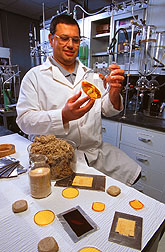Science + Sucrose = New Liquid Epoxies
Sugar is still a favorite sweetener for drinks, desserts, and other foods, but artificial sweeteners are nibbling on its piece of the consumer pie.
If the nation's sugar producers are dismayed by such prospects, they may find solace in a new advance in polymer science. By changing sugar's molecular structure, scientists have created powerful liquid epoxies that bind concrete, wood, metals, plastics, and other materials.
"Once these epoxies set, they become a clear, glassy or rubbery material, depending on the type used," says chemist Navzer D. Sachinvala of USDA's Agricultural Research Service.
Preliminary studies suggest a range of potential applications—from primers, base coatings, and adhesives to composite materials like particle board and boat hulls.
It's too soon to say how epoxy resins might fare versus petroleum-based products. But epoxies have some compelling selling points, such as a tenacious grip on different materials and a range of curing temperatures.
And unlike today's petroleum products, the sucrose epoxies don't contain ingredients like bisphenol-A. Some scientists worry that this chemical may disrupt the endocrine systems of animals such as mice—and possibly humans—notes Morton Litt, a Case Western Reserve University professor in Cleveland, Ohio.
Sucrose also proffers a handy, domestic source of raw material, compliments of sugarcane industries in Florida, Louisiana, Texas, and Hawaii. Together they produce about 3.8 million tons of sugar annually. Only about 2 percent is used for nonfood purposes.
"It's the purest, most versatile organic compound you can find, and yet it has only one major commercial use: food," says Sachinvala.
He first began exploring its industrial potential in 1988, along with Litt and other colleagues at what is now the Hawaii Agricultural Research Center on Oahu.
Initially, they tried developing nylons, polyesters, and polyethers, but "they were difficult and expensive to make from sucrose," says Sachinvala. Then they tried making the epoxies from what are called allyl- and crotyl-substituted sucroses. Despite difficulties, success finally came with the use of common reagents, like oxygenated vinegar, and a reliable method of controlling a critical step called epoxidation.
In October 1998, they published research results in the Journal of Polymer Science comparing crotyl and allyl sucrose epoxies with the petroleum product diglycidyl ether of bisphenol-A, or DGEBA. The bonding strength of the crotyls proved superior to both the allyl and DGEBA epoxies—the latter by 30 percent. In fact, in tests, it took over 1,000 pounds of force to separate two small, aluminum plates (4" x 1" x 0.044") coated with the crotyl material.
Since publishing, the scientists have refined the epoxy-making process, improving its efficiency and environmental friendliness. What's left over are byproducts like salt and vinegar.
Under a cooperative agreement, the scientists are transferring the sucrose technology to Cajun Materials Group, Inc. (CMGI), a business consortium in New Iberia, Louisiana.
The aim is to produce large amounts of epoxy material so its commercial potential can be determined in a market dominated by petroleum-based products. Acadia Board Co., a CMGI affiliate, hopes to use the epoxies and crushed plant fibers to create composite material for home building.
Such collaboration, Sachinvala says, will help gauge commercial factors of price, performance, and advantage over existing materials. All could foretell whether big things come from the Bayou country—and whether sugar rises above its sweetener status.— By Jan Suszkiw, Agricultural Research Service Information Staff.
This research is part of New Uses, Quality, and Marketabilty of Plant Products, an ARS National Program described on the World Wide Web at http://www.nps.ars.usda.gov/programs/cppvs.htm.
Navzer D. Sachinvala is at the USDA-ARS Southern Regional Research Center, 1100 Robert E. Lee Blvd., New Orleans, LA 70124; phone (504) 286-4324, fax (504) 286-4271.
"Science + Sucrose=New Liquid Epoxies" was published in the June 1999 issue of Agricultural Research magazine.







